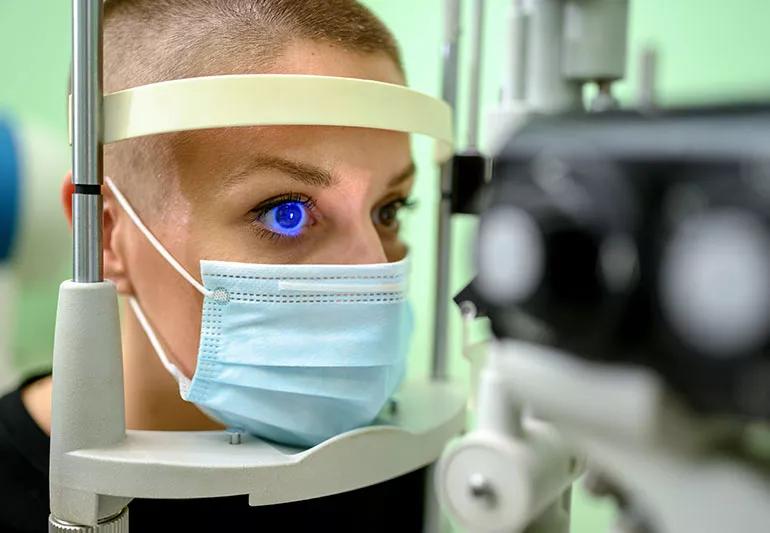What to do if you suddenly see lots of new ‘floaters’

Posterior vitreous detachment is quite a mouthful (and sounds a bit scary). Fortunately, this eye condition usually won’t threaten your vision or require treatment. But it can sometimes signal a more serious, sight-threatening problem. So it’s best to be checked by an ophthalmologist (a specialist who treats eyes) right away.
Advertisement
Cleveland Clinic is a non-profit academic medical center. Advertising on our site helps support our mission. We do not endorse non-Cleveland Clinic products or services. Policy
How can you tell that your vitreous may have detached? By a sudden increase in floaters — those small, typically harmless shapes that drift across your field of vision as you move your eyes.
“Vitreous detachments are pretty common,” says professor of ophthalmology at Cleveland Clinic Lerner College of Medicine Rishi P. Singh, MD. “When you see these new floaters, it’s best to have them evaluated and, specifically, to have a dilated eye examination performed by an ophthalmologist.”
The vitreous, a gel-like substance, accounts for 80% of the volume of your eye. It fills the interior of your eye and helps to preserve its round shape, as well as allows for light to pass through to your retina.
Tiny collagen fibers secure the vitreous to its base near the front of your eye. They also secure it to your optic nerve and retina in the back of your eye.
But, over time, the collagen fibers degrade, or wear down, and the vitreous gradually liquefies. This makes the gel unstable, and the vitreous contracts, moving forward in the eye and separating from your retina.
When this happens, you see new floaters — caused by stringy strands in the vitreous that are casting shadows on your retina. Often, they’re accompanied by flashes of light — usually in your peripheral vision — and especially visible in the dark.
Advertisement
The flashes and floaters generally subside within one to three months, and 85% of people with posterior vitreous detachment experience no further problems.
Usually, as the vitreous shrinks, the collagen fibers connecting it to the retina break off, and no harm is done.
Occasionally, however, the fibers don’t break off easily and tug at your retina instead. If they pull hard enough, the tension can detach your retina or tear it. Both conditions can cause vision loss and require immediate treatment.
“Very few people with vitreous detachment have a very serious tear or retinal detachment,” Dr. Singh notes.
But both vitreous and retinal detachment can cause a spike in flashes and floaters, so it’s hard to distinguish between the two.
“You actually have to go in and have an evaluation to determine that,” he adds. “If you have those symptoms, definitely make sure you get checked.”
Retinal tears are treated with office-based procedures using lasers or extreme cold to seal the tear.
Retinal detachments are treated in the same way but also require surgery to reattach your retina to the back wall of your eye.
During surgery, it may be necessary to remove the vitreous. Surgeons will inject gas into your eye to fill the space occupied by the vitreous. This temporarily holds your retina in place, as your eye heals and produces fluid that replaces the vitreous permanently.
“These vitreous detachment treatments are very successful, and their success rate approaches 90%,” Dr. Singh says. “But earlier treatment is important because people who get treated earlier get better results.”
The risk factors for vitreous detachment include:
People over age 60 are more likely to develop vitreous detachment. But if you’re nearsighted or have suffered eye trauma, you’re more likely to develop it at a younger age. And if you’ve had vitreous detachment in one eye, you’re likely to experience it in the other eye within a year.
It’s good to be aware when you’re at increased risk — then you’ll know to see an ophthalmologist promptly if new floaters and flashes develop. The biggest signs for concern of a retinal tear or detachment are a black cloud or veil in your vision, which you cannot see through, persistent flashing lights or a shower of floaters.
Meanwhile, remember to safeguard your eyes. Wear protective goggles when you play sports, when you work with saws or other tools that create debris, and when you handle more dangerous items like fireworks.
Advertisement
Learn more about our editorial process.
Advertisement

It’s critical to have the proper eyewear if you plan to look up at the sun, especially during the total solar eclipse on April 8, 2024

Early morning red eyes can be a sign of several conditions, like dry eyes, allergies and eye strain

See an eye specialist if your pain isn’t going away and comes with other symptoms

Your eyes could be burning because of allergies, elevated salt levels, dry eyes and more

One is a raised yellow spot on your eye, the other is a fleshy growth

Be patient and try at-home remedies like applying a cold compress and elevating your head while sleeping

Too much blue light, especially from digital sources, may lead to eye strain and computer vision syndrome

Having a first-degree biological relative with this eye condition raises your risk, but other factors are at play, too

The best parenting style balances enforcing rules and showing plenty of love

Tips include cutting back on sugar, focusing on exercise and managing stress

It can be harder to let go when you’ve invested time, energy and emotions — but it might be the healthier choice long term